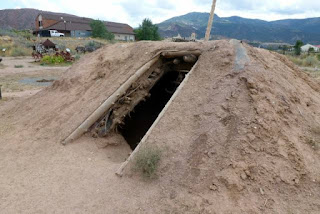Utah’s earliest
white settlers were a group of Mormons who travelled into the uncharted West to
avoid persecution. Led by Brigham Young, they settled in what is now Salt Lake
City in 1847.
Young sought self
sufficiency, which needed iron. Ore was discovered 250 miles south, and
volunteers were enlisted to develop the area for an iron works. In 1851 the new
settlers arrived where Cedar City now stands. But they needed an expert, and fortunately
had one in Richard Harrison who was previously been superintendent of the world’s
largest iron foundry in Liverpool. He came with the initial wave of settlers,
and designed and built the first iron works. It produced its first iron from
local ore on Sept 30th 1852. Some achievement, from a standing
start!
The local Frontier
Homestead Museum celebrates those early days with interesting memorabilia, if presented
somewhat haphazardly.
Out the front is an
1920’s excavator used for scooping iron ore. I guess it could scoop almost
anything. The machines were never used in the locality as the iron works unfortunately
didn’t thrive, and closed in 1858.
Here’s a rickety wild
west stagecoach demonstrating, if nothing else, how uncomfortable the ride must
have been. Dangerous, too, as the stage has a bullet hole in the side.
And now a
reconstructed settlers cabin from the late 19th Century. Jane thinks
she could live in this just fine as it’s about the same size as our caravan
back home. Also it’s more arrow-proof than our caravan, but no cassette loo.
You don’t ask.
Because
of the elevation here, over 5,000 feet, winters can be cold and snowy. A local
inventor came up with a snowmobile in the 1940’s. Although it looks more like a
midget submarine, apparently it did work and was a great success leading to the
much more sophisticated machines of today.
Probably
the most interesting exhibits were the dwellings of the Southern Native
Americans. These are called wickiups, made from woven rushes, or bark, or branches
in a variety of designs and sizes. These were used until about a century ago. The museum examples
don’t look as if they would offer much shelter in bad weather- or even good
weather, come to that.
The
pit houses of the Fremont peoples who lived in the area until the 13th
century seem much more substantial. They were farmers and possessed
sophisticated artifacts like pots and ornaments that have been found, but
little is known about their culture, and we don’t know why they suddenly
disappeared.
Cedar
City is now pleasant smalltown America, complete with national fast food chains,
shops and garages. However, the “Historic Center” has been preserved which
contains its core of individuality.
Nearby
is Kolob canyon. It’s rather overshadowed by its near neighbour Zion that we visited a few days
ago,but it’s quite spectacular in its own right. There are some excellent
walks within, as can be seen from this trailhead.
Moving
up into the canyon itself, the 1000 foot red rock walls are very impressive.
Driving
and climbing all the way to the end of the scenic 6 mile paved road is an
overlook that puts you nearly level with the top of the walls. Description
boards point out hidden valleys where streams feed dense stands of firs. Cougars
have been spotted but no chance for casual visitors. It fact there wasn’t much
wildlife beyond the occasional bird, rabbit, lizard and squirrel.
Unlike
Zion, there were only a handful of cars, so we had a leisurely morning in yet
another magnificent American scenic park.











No comments:
Post a Comment